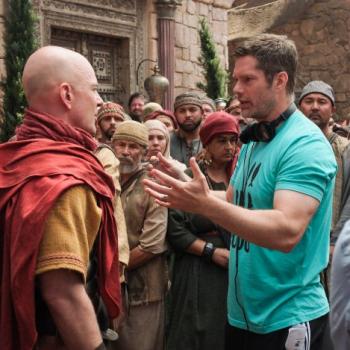Season 1, Episode 10 — ‘Brothers in Arms’
Acts 9:28-31
Editing Acts, redux. The tenth episode of A.D. The Bible Continues is based on just a few verses from Acts 9, but it also borrows elements from other passages in Acts.
The episode depicts how Saul stayed with the apostles in Jerusalem (9:28), how the apostles sent Saul home to Tarsus when his life was in danger (9:29-30), and — through the truce arranged by James the Just and the high priest Caiaphas — how the persecution of the church came to a temporary end after Saul left (9:31).
The episode does not depict Saul arguing with the Hellenistic Jews (9:29). Saul’s life is threatened in this episode by the Zealots instead. (This is not the first time A.D. has ignored the Hellenistic Jews; it ignored them in the fifth episode, too.)
This episode also does not make any use of the passage in Acts 22 in which Paul says he left Jerusalem because Jesus appeared to him in a vision and told him to leave.
This episode does introduce or expand upon three characters who figure prominently in other sections of the book of Acts.
First, we see more of Tabitha, who was introduced in the last episode and is now punished by Pilate for becoming a Christian. The wounds she sustains in this episode will lead to her death and subsequent resuscitation, as per Acts 9.
Next, there is the Ethiopian eunuch, who receives a copy of the book of Isaiah from Caiaphas. The eunuch and the scroll are mentioned in Acts 8, when Philip meets the eunuch on the road to Gaza — but that meeting won’t happen until the eleventh episode. Also: the biblical eunuch had gone to Jerusalem to worship, before he met Philip, whereas the eunuch in A.D. has gone for a more… political reason.
Finally, and most significantly, there is James the Just.
James is identified in the Bible as one of the “brothers” of Jesus, along with Joseph, Judas and Simon (Mark 6, Matthew 13).1 The brothers did not believe in Jesus during his ministry (John 7) and actively tried to stop him at one point (Mark 3), but then Jesus appeared to James after the Resurrection (I Corinthians 15) and, by Pentecost, the brothers were meeting and praying with the apostles regularly (Acts 1).2
None of this back-story is mentioned in A.D., except for the fact that James is some sort of kinsman of Jesus.3 As far as this episode is concerned, James is an old friend of Peter’s who has been living in Galilee this whole time (since before Jesus died) and who has now popped down to Jerusalem because of a dream he just had.
But the episode does acknowledge that James was a significant enough figure by the time of Saul’s conversion that Saul met him during his stay in Jerusalem, as per Galatians 1. And it does foreshadow how James will become a leader in the Jerusalem church, as per Acts 12, 15 and 21 — and how his leadership there will sometimes put him at odds with the more “radical” teachings of Saul, as per Galatians 2.
Scripture references, redux. Caiaphas performs the Yom Kippur (or Day of Atonement) ceremonies described in Leviticus 16, including placing all of the nation’s sins upon a goat and sending it into the wilderness to die.
The episode cross-cuts between the scapegoat and the apostles sending Saul away from Jerusalem, as if to suggest a thematic link between the two.
Saul says “Isaiah’s prophecy has been completed.” He doesn’t say which prophecy, but other episodes have pointed to the “suffering servant” passage in Isaiah 53.
James remembers finding Jesus in the temple when Jesus was a boy — but in Luke 2, it was Mary and Joseph who found Jesus in the temple, not James.
Two of Jesus’ teachings are referenced in this episode. Joanna and Mary Magdalene tell Tabitha the “eye of a needle” story from Mark 10, Matthew 19 and Luke 18 — fitting, since Tabitha is a seamstress — and Saul says Jesus came not to abolish the Law but to fulfill it, which is something Jesus said about himself in Matthew 5.
Saul also comforts Tabitha with a passage from Romans 8, which the historical Saul, going by the name Paul, wrote about 20 years after the events of this episode.
Leah recites a prayer that begins: “Blessed Lord, I have shut my ears to your teachings and ignored your commandments. I have closed my eyes to the suffering of others…” This sounds like a formal prayer, but I can find no precedent for it.
Introducing Saul, redux. This episode plays up Saul’s indifference to the temple and to Jewish rituals in general. He tells Caiaphas that there is no point to bathing in mikvahs etc. now that Jesus has come; he preaches that everyone can be born again and be free of the temple’s tyranny; and he asks the other Christians why they should respect “that pile of stones” just because James told Caiaphas they would.
I do like the scene where Saul says farewell to the apostles. As performed by Emmett J. Scanlan, there are some subtle emotional shifts on Saul’s face as he seems to feel alternately rejected and accepted by the apostles; he gives Peter one last hug, and he takes one last humourous little dig at Simon the Zealot. It’s a perfect send-off, and it makes me hope that we will get to see these characters meet again someday.
Political friction, redux. The Ethiopian eunuch, surprisingly, comes to Jerusalem not to worship, per se, but to make a financial contribution to the Zealots. He also agrees to attend a banquet at Pilate’s palace as per the governor’s demand.
Caiaphas says repeatedly that he wants to unite the Jews of all sects, including the Christians, to deal with the crisis that will arise when the Romans try to put Caligula’s statue in the temple. However, Caiaphas is not keen to include Saul in that unity.
It’s interesting how both Caiaphas and the Zealots want to defend the temple, but Caiaphas, who once handed Jesus over to be crucified by the Romans, is willing to let Saul go free, on the assumption that the mob will kill Saul once they hear his preaching — whereas the Zealots, with a bit of encouragement from Caiaphas’s wife Leah, want to kill Saul precisely to stop people from hearing his preaching.
When Pilate hears that Joanna and Tabitha are Christian, he orders that they be punished so the whole world from Rome to Ethiopia will know; Pilate’s wife Claudia asks if the emperor would really care about something as tawdry as this.
Violence, redux. Cornelius rips the back of Tabitha’s shirt and flogs her.
Leah and the Zealots plot to kill Saul, but he escapes before they can do anything.
Family matters, redux. After Pilate punishes Tabitha in front of his guests, he tells Claudia privately that she cannot show her disapproval of his actions in public.
Both Leah and Claudia go behind their husbands’ backs — Leah to plot the death of Saul with the Zealots, Claudia to let Mary Magdalene go scot-free.
Joanna is visited in prison by her husband Chuza, who fears she will die. She tells him she is happy, he was the best husband, and he should be happy too.
Historical reference points, redux. The sixth episode took place during Purim. This episode takes place during Yom Kippur, which is about seven months after Purim. Does it seem like seven months went by over the last four episodes?
Odds and ends. Saul scratches a fish symbol on the wall of his prison cell, similar to the fish symbol Barnabas found on the door of the Christians’ hiding place in the previous episode. But Saul, unlike most of the other apostles, is not a fisherman, so what does the symbol mean for him? Is it a reminder of the apostles in general? Has the symbol already begun to take on its special meaning as a Greek acrostic?
–
1. Mark and Matthew also note that Jesus had an unspecified number of anonymous sisters.
2. John 2 seems to indicate that the brothers of Jesus also went with him, his mother and his disciples to the wedding at Cana where Jesus performed his first miracle (i.e. turning water to wine).
3. Different churches have different beliefs on the exact nature of James’s relationship to Jesus because of its implications for beliefs about Mary’s virginity: Protestants tend to believe James was a half-brother of Jesus, i.e. that they had the same mother; Orthodox tend to believe James was a step-brother of Jesus, i.e. a son of Joseph’s from a previous marriage; and Catholics tend to believe James was a cousin of Jesus.
A.D. seems to be following the Catholic view that James was a cousin of Jesus. He is too close in age to be an older step-brother, and when he tells the story of how the young Jesus went missing in the temple, James says, “His mother was beside herself with worry.” Note: his mother, not our mother.
Incidentally, have you noticed that we haven’t seen Mary for several episodes now? If she were still here, this episode might have had to take a stand and specify whether she was James’s mother or not.
–
CT Movies recaps: one | two | three | four | five | six | seven | eight | nine | ten | eleven | twelve
FilmChat recaps: one | two | three | four | five | six | seven | eight | nine | ten | eleven | twelve













